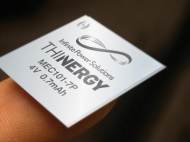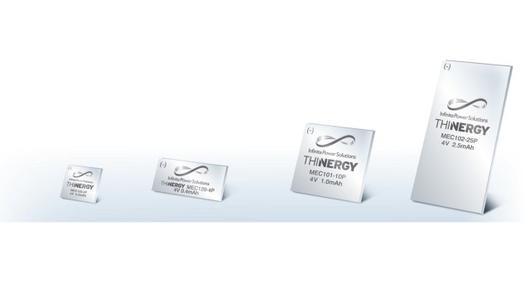THINERGY batteries replacing old thin-filmed batteries
 The new line of THINERGY Micro-Energy Cells from Infinite Power Solutions Inc (IPS) could soon be powering small devices such as autonomous wireless sensors, powered smart cards, active RFID applications, and implantable medical devices. The manufacturer says these rechargeable thin-film batteries combine the energy density of traditional batteries with the high discharge current of supercapacitors. They are designed to outperform Lithium coin cells, printed batteries and other thin-film batteries.
The new line of THINERGY Micro-Energy Cells from Infinite Power Solutions Inc (IPS) could soon be powering small devices such as autonomous wireless sensors, powered smart cards, active RFID applications, and implantable medical devices. The manufacturer says these rechargeable thin-film batteries combine the energy density of traditional batteries with the high discharge current of supercapacitors. They are designed to outperform Lithium coin cells, printed batteries and other thin-film batteries.
Each MEC is a thin, flexible unit that can be easily incorporated into compact hardware designs. Multiple MECs can be stacked to increase capacity and output without increasing the unit’s footprint. The THINERGY MECs are even thin enough to be embedded and laminated into printed circuit boards or other materials.
IPS is offering the following four THINERGY Micro-Energy Cell models MEC125, MEC120, MEC101 and MEC102. Their characteristic regarding size and capacity varies. You can see those characteristics at this page on their website. The MEC120 and MEC 101 are available now. The MEC125 and MEC102 will be available in the fourth quarter of 2009.
The THINERGY MECs are made from sold-state chemistry, with no liquid or organic polymer electrolytes used. IPS says this construction allows the MECs to support more recharge cycles than other rechargeable batteries, and to hold their charge longer with less loss. A fully-charged MEC will lose less than 1% of its charge over a year.
The Micro-Energy Cells have no “memory” effect like other battery technologies, so they retain their full capacity throughout their life. Each MEC requires only 4.1V for charging, and can accept a charge with as little as a few hundred nA of current. Depending on the charging current, a MEC can recharge in as little as a few seconds or as long as 10 minutes.
THINERGY MECs can be recharged beyond 10,000 cycles, making them perfect for trickle charge (constant recharge) applications, such as when used as a backup battery or when integrated with energy harvesting circuits. The recharge takes from a few seconds to a few minutes, depending on the state of discharge.
IPS claims the charging characteristics of its THINERGY MECs make them ideal for applications involving energy harvesting from sources such as solar, RF (converting radio frequency into current), kinetic, or thermoelectric. In addition they can be charged using more conventional methods such as direct wire connection and inductive charging (using a magnetic field to induce current).
The energy harvesting solutions provide a continuous, autonomous power source that, depending on the design, may provide a sufficient trickle charge to the battery such that a conventional direct wire recharge may never be needed, allowing decades of power without battery replacement.










We are moving fast from macro to micro and from thick to thin in Technologies especially in energy related ones.Miniature has become the order of the day.
Dr.A.Jagadeesh Nellore(AP),India
Charging batteries is the issue, I have reach a fact that leaves of a tree can charge the batteries.
So do we need batteries to do so?
Be green Save more…
Hi friends, my name is Vladimir,
and I need two battery models –3,7 V… 1,2-7-20mm is a model / thin 1,2 mm
and the other model is 0,5-15-17mm / thin 0,5 mm
betwen 9 mAH and 15 mAH
in total 200 pieces of each model I
I would like 400 pieces of both models
depends and that would be the price that
I have to sell, thank you very much and
look a replied to my email address,
and if you can give me please id Skype or a
chat where we can communicate better
Can you help me with this problem or
whether these measures can not I need
something that is very close to these measures,
but if you could do me these two models would be perfect for me
please give me one id Skyp